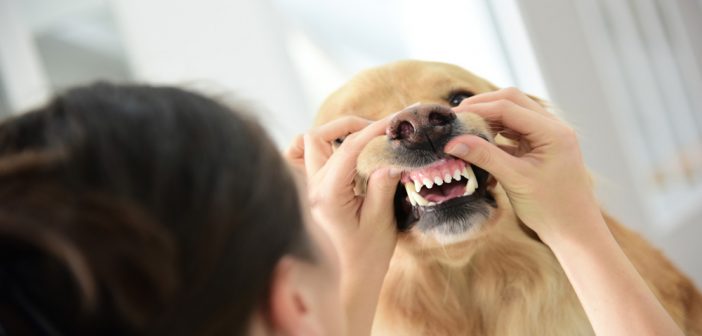You are the ultimate pet parent: You make sure your beloved pet eats a healthy, well-balanced diet, sees the veterinarian regularly, and gets plenty of exercise, attention and love. But when is the last time you checked out your pet’s teeth and mouth?
Signs your Dog may Have Oral Hygiene Problems
• Tooth tartar that is yellow-brown
• Bleeding Gums
• Red and swollen gums
• Difficulty chewing when eating
• Dropping food when eating
• Large amounts of drool
• Change in eating habits
• Pawing at the mouth
More than 85 percent of dogs who are 4 years old or older suffer from some type of gum disease, according to veterinarians. If you leave the condition untreated, it can lead to tooth loss and infection. The good news is, if you brush your dog’s teeth at least four times a week and take your dog for regular cleanings and checkups, tooth trouble can be prevented.
Your dog will probably not “open wide” without a struggle when you attempt to brush his/her teeth. If you have a puppy, get him/her accustomed to tooth cleanings early on. If your dog is older, it will take some time to adjust, so be patient.
Tips for Dogs Who Hate Teeth Brushing
1. Dab some peanut butter or yogurt on your finger and let your dog lick it off while you gently massage his/her teeth and gums. Apply more of the treat as you gradually expose more of his/her teeth.
2. Get your dog used to you handling his/her muzzle. First, place one hand underneath his/her lower jaw and the other on top. Keep your hands there for a few seconds before you begin moving his/her mouth around by parting his/her lips and gently opening his/her jaw.
You should brush your dog’s teeth at a time of day when you got the time and it is unhurried, calm and peaceful. Let him/her sniff the toothbrush and toothpaste before you begin. Remember that dogs quickly pick up on your emotions, so if you are relaxed and happy while brushing your dog’s teeth, he/she will be as well.
Dental Tips for Dogs
1. Select a soft-bristle human toothbrush that fits your dog’s mouth. There are also dog toothbrushes on the market which you can place over your finger. Pick the one that works best for you and your dog.
Never, use human toothpaste when brushing your dog’s teeth. Dogs can’t spit and he/she will swallow the detergents and abrasives. Instead, use canine toothpaste in a flavor your dog loves.
If you don’t have time for a toothbrush and toothpaste, consider buying some dental wipes. They can be used to/will wipe away harmful bacteria and food particles.
2. Quality dog food not only nourishes your dog, it promotes stronger teeth. Avoid foods made with by-products, cereal grains and meals. These will stick to your dog’s teeth. Instead, select a dog food that is composed of meat, vegetables and fruit.
3. Most dogs love carrots, apples, squash or pumpkin and these snacks won’t stick to their teeth. They will also help remove food from his/her teeth. Avoid snacks that are made of sugars, cereals and fats. Dried meat treats will also help to remove food from your dog’s teeth. Raw, uncooked bones act in a similar manner when your dog chews on them.
4. Chew toys are fun and can help improve your dog’s dental health. If your dog loves gnawing on a chew toy, he’s not only having fun, he’s cleaning his teeth at the same time.









